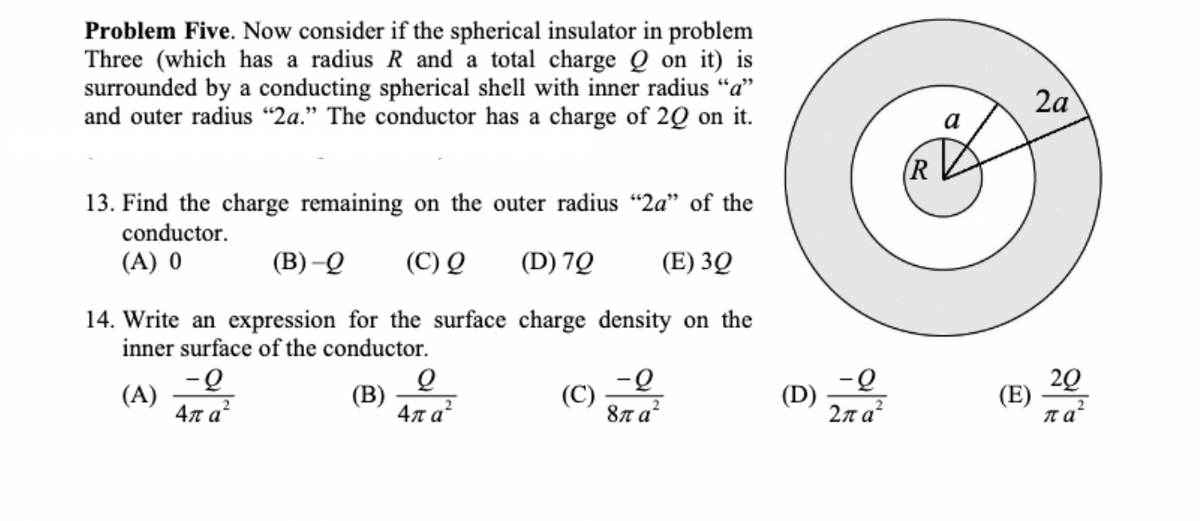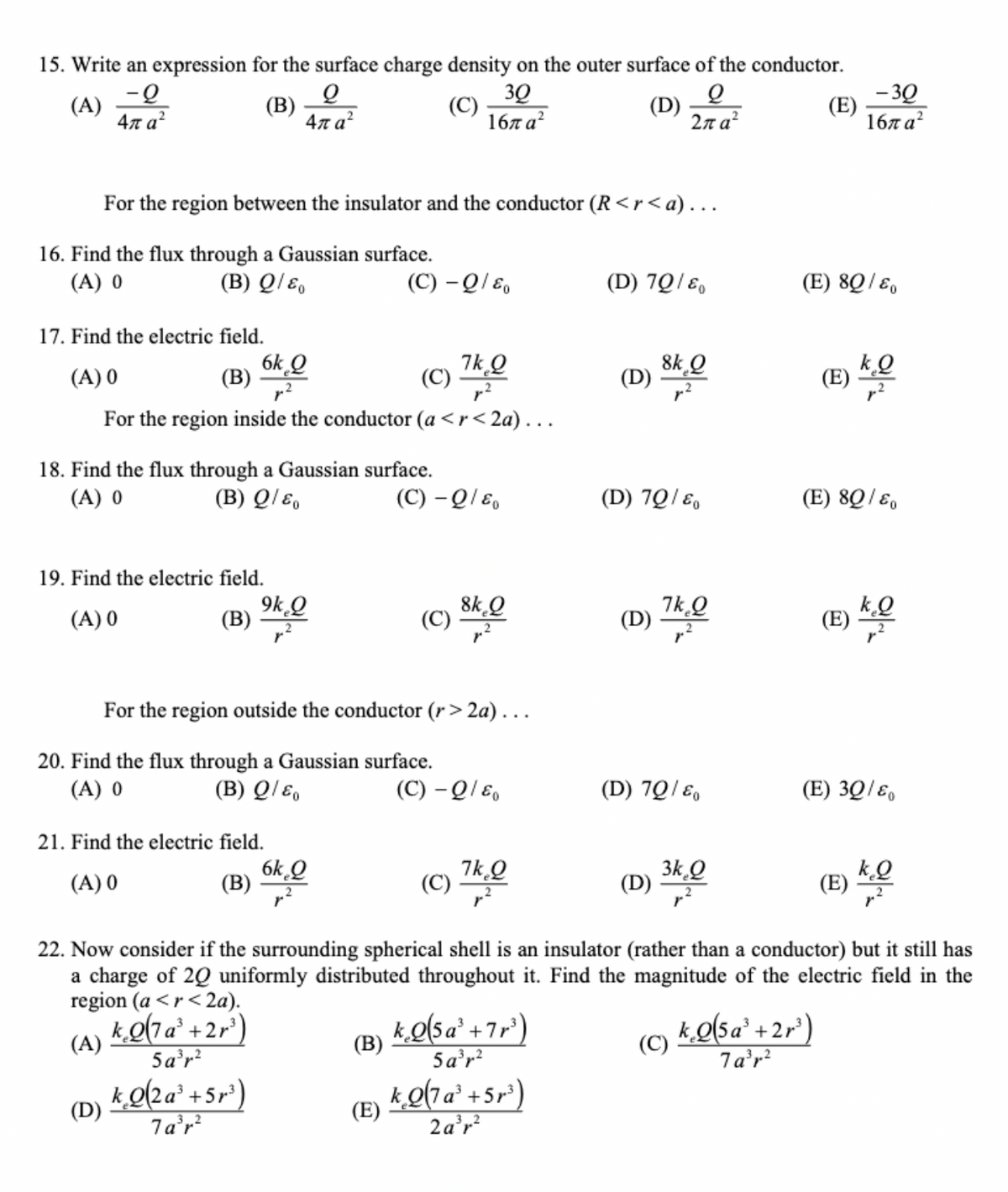Problem Five. Now consider if the spherical insulator in problem Three (which has a radius R and a total charge Q on it) is surrounded by a conducting spherical shell with inner radius "a" and outer radius "2a." The conductor has a charge of 20 on it. 13. Find the charge remaining on the outer radius "2a" of the conductor. (A) 0 (B)-Q (C) Q (D) 70 (E) 30 14. Write an expression for the surface charge density on the inner surface of the conductor. (A) -Q 4π a² (B) Q 4π a² (C) -Q 75 8π a² (D) Σπαζ (E) 2a 20 πα
Problem Five. Now consider if the spherical insulator in problem Three (which has a radius R and a total charge Q on it) is surrounded by a conducting spherical shell with inner radius "a" and outer radius "2a." The conductor has a charge of 20 on it. 13. Find the charge remaining on the outer radius "2a" of the conductor. (A) 0 (B)-Q (C) Q (D) 70 (E) 30 14. Write an expression for the surface charge density on the inner surface of the conductor. (A) -Q 4π a² (B) Q 4π a² (C) -Q 75 8π a² (D) Σπαζ (E) 2a 20 πα
Physics for Scientists and Engineers: Foundations and Connections
1st Edition
ISBN:9781133939146
Author:Katz, Debora M.
Publisher:Katz, Debora M.
Chapter25: Gauss’s Law
Section: Chapter Questions
Problem 68PQ: Examine the summary on page 780. Why are conductors and charged sources with linear symmetry,...
Related questions
Question
I need help with this problem. These are the correct answers and I understand some but the others I don't get how to solve.

Transcribed Image Text:Problem Five. Now consider if the spherical insulator in problem
Three (which has a radius R and a total charge Q on it)
surrounded by a conducting spherical shell with inner radius "a"
and outer radius "2a." The conductor has a charge of 20 on it.
13. Find the charge remaining on the outer radius "2a" of the
conductor.
(A) 0
(B)-Q (C) Q
(D) 70
(E) 30
14. Write an expression for the surface charge density on the
inner surface of the conductor.
-Q
(A)
4π a²
(B)
Q
4π a²
(C)
-Q
8π a²
(D)
-Q
2πατ
a
(E)
2a
20
παζ

Transcribed Image Text:15. Write an expression for the surface charge density on the outer surface of the conductor.
Q
(A)
-Q
4π a²
(B)
(C)
30
16πα2
(D)
2πατ
For the region between the insulator and the conductor (R<r <a)...
16. Find the flux through a Gaussian surface.
(A) 0
(B) Q/&
Q
4πα?
17. Find the electric field.
(A) 0
(C) 7k,Q
(B)
For the region inside the conductor (a <r<2a)...
19. Find the electric field.
(A) 0
(B)
6k Q
18. Find the flux through a Gaussian surface.
(A) 0
(B) Q/E
(D)
9k₂Q
21. Find the electric field.
(A) 0
kQ2a³+5r³)
7a³r²
(C) - Q/&
20. Find the flux through a Gaussian surface.
(A) 0
(B) Q/&o
6k Q
(B)
For the region outside the conductor (r>2a)...
(C) - Q/&
(B)
(C)
)
(E)
8kQ
(C) - Q/E
7kQ
(C) 7h0
k₂Q(5a³ +7r³)
5a³r²
(D) 70/80
kQ(7a¹ +5r³)
2a³r²
8kQ
(D) 70/80
Q
D) 7k ₂0
(D)
(D) 70/80
3k Q
(D) 34,0
(C)
(E)
(E) 80/80
22. Now consider if the surrounding spherical shell is an insulator (rather than a conductor) but it still has
a charge of 20 uniformly distributed throughout it. Find the magnitude of the electric field in the
region (a <r<2a).
k.Q(7 a³ +2r³)
(A)
5a³r²
-30
16πα2
(E) 80/80
(E)
k₂Q(5a³ + 2r³)
7a³r²
kQ
k₂Q
(E) 30/80
kQ
(E)KO
Expert Solution
This question has been solved!
Explore an expertly crafted, step-by-step solution for a thorough understanding of key concepts.
This is a popular solution!
Step 1: Determine the charge at outer surface of shell
VIEWStep 2: Calculate the surface charge density of inner shell
VIEWStep 3: Calculate the surface charge density of outer shell
VIEWStep 4: Calculate the flux and electric field between insulator and conductor
VIEWStep 5: Calculate the flux and electric field within shell
VIEWSolution
VIEWTrending now
This is a popular solution!
Step by step
Solved in 6 steps with 5 images

Knowledge Booster
Learn more about
Need a deep-dive on the concept behind this application? Look no further. Learn more about this topic, physics and related others by exploring similar questions and additional content below.Recommended textbooks for you

Physics for Scientists and Engineers: Foundations…
Physics
ISBN:
9781133939146
Author:
Katz, Debora M.
Publisher:
Cengage Learning

Physics for Scientists and Engineers: Foundations…
Physics
ISBN:
9781133939146
Author:
Katz, Debora M.
Publisher:
Cengage Learning